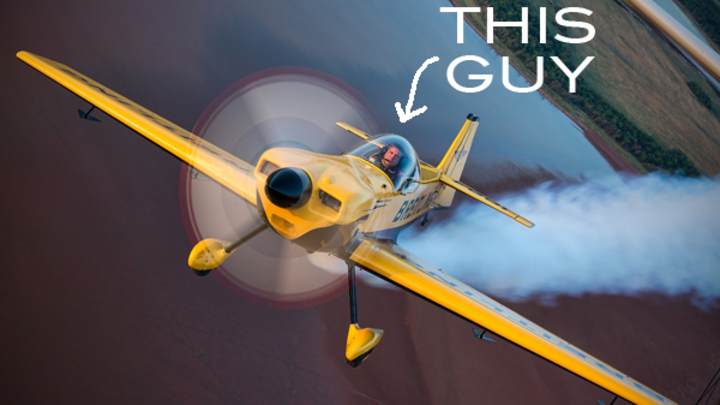Don't Call Him a Stunt Pilot: An Aerobatic Competitor Talks Shop


David Martin flies his Breitling CAP 232 plane upside down, sideways, and in circles, all on behalf of the United States Aerobatic Team. We talked to him about his military background, the difference between airshows and aerobatics competitions, and why he sticks with the underfunded pastime.
EM: You do tricks in an airplane for a living. What's the proper terminology here? Are you a stunt pilot? Aerobatic competitor?
Martin: I'd say aerobatic competitor, or airshow pilot. "Stunt pilot" is kind of an old term. The only people who say "stunt pilot" are ones who don't know much about aviation. Back in the 1920's and 30's they were called stunt pilots, but we try to stay away from that now.
I know you have a background as a military pilot. How'd you transition from that into aerobatics?
I actually started flying aerobatics in competitions before I was in the service. I've been doing it since I was 16. My grandfather and father were both airline pilots, and back when my grandfather was training to fly in the 20's, almost everybody learned basic aerobatics. He wanted me to know them when he taught me to fly, which is how I got into it. We had an aerobatics version of the most basic airplane, the Cessna 150, and that's what I started in. My first trick was an aileron roll—rolling the airplane around the longitudinal axis.
How does your background compare to those of other aerobatic pilots?
There's no set path to getting there, flying-wise. There are pilots from all different experiences—airline pilots, former military pilots, all different kinds. On the USA Aerobatics team, we have everyone from an up-and-coming young airshow pilot to an attorney who flies on the side. Most people just get into aerobatics to improve their flying—it's a good way to become a better pilot. In the military, everyone learns aerobatics. Just part of our training.

Does that hold true for airline pilots, too?
There are differing schools of thought on that. Most pilots who have never done aerobatics have never been upside-down before. That includes a lot of airline pilots. The FAA used to require that pilots at least learn basic aerobatic maneuvers, but they changed that policy, I think after World War II. The FAA has a theory now that if you've never done an aerobatic maneuver before, you're not going to accidentally do one while flying. That's wrong. It's rare, but things can happen while flying that cause you to inadvertently be upside down. A friend of mine is an airline pilot, and during one of his flights a flap came down and sent the plane into uncontrolled rolls. Because he had aerobatic experience, he was able to save it. The training is your lifejacket.
You ever have a close call like that during competition?
In the World Competition in 2003, I had a control failure. We fly four sequences during a contest, which are comprised of like eight or nine maneuvers in a short period of time. During my second sequence something didn’t seem right, and when I leveled off between maneuvers I looked out at the wings and both ailerons were up, which is impossible unless something’s broken. I stopped my sequence, and upon determining that the plane was still controllable, I landed it. That would be the closest. I've never thought I was going to die or anything.
Airshows vs. Aerobatics competitions. You've talked about the two as separate things. What are the differences?
One of the big things is the height limit. In airshows, you usually have the whole length of the runway, which in most cases is like 6-7000 feet; where in competition it’s basically 3000 feet. You have to fly in a 3300-foot box. Basically an imaginary box in the air in competition. If you go out of that, you’re downgraded for it. In airshows, the only real restriction you have is you can’t fly closer than 500 feet to the crowd line.
Is trick flying a lucrative enterprise? What do you get if you win an aerobatics competition?
[Laughs] You get a trophy or a medal. In local competitions, you get a small trophy. In national competitions, you get a little bigger trophy. And in world competitions, you get medals for the individual. Overall World Champion gets a trophy but there’s no money. There was some money way back in the early days, but there hasn’t been any since I was around. I don’t there’s ever been any money in the world competitions. Some national competitions did give some prize money, but like I said, there’s never been any since I’ve been flying in the last 20 years.
Do you know why that changed?
I just don’t think anybody wants to put up any money. It’s just not that big of a market.
So it's more a labor of love?
Right, yeah. Sometimes you wonder why you're doing it.

